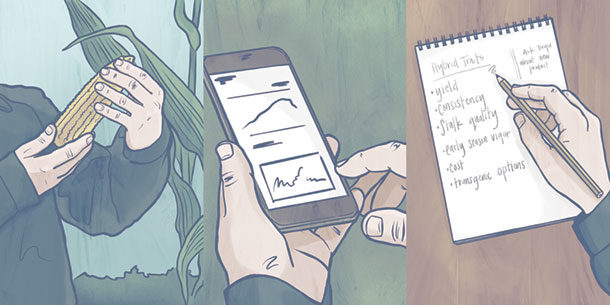Planning for next year’s corn crop that will be chopped for whole-plant silage requires a to-do list – though, given the crop and the method of harvest, we’ll call it a three-item “chopping list.”
No. 1: Corn hybrid selection
This past summer, I was speaking to a group of vet college seniors and recent graduates at the Cornell University College of Veterinary Medicine, and a veterinarian in the audience commented on the lack of sufficient corn hybrid yield and quality data from state university testing programs.
In most cases, this isn’t the fault of the universities, which can only test the hybrids submitted by the various seed companies. Most seed companies have a lot more hybrids they promote for silage harvest than can practically (or economically) be tested in university trials, so the tendency is to enter their newest, most promising hybrids.
Corn silage trials are much more expensive to run than grain trials because of the forage quality analysis (including neutral detergent fiber digestibility) universities include in their reports.
If university testing programs can’t provide the data, you can still make informed decisions on hybrid selection. Two sources of information are seed dealers and your own experience. A reliable seed dealer can be a great source of information on the hybrids a company sells. Not only does the dealer have access to company-generated data, but he sees how these hybrids perform on area farms.
The best information can be from strip trials on your own farm. Avoid making field-to-field comparisons because of likely differences in soil type, planting date, field history, etc. Strip comparisons should be in the same field, avoiding those with large in-field differences in drainage or soil type.
While university trials often plant four rows of each hybrid, I’d recommend wider strips – perhaps 16 rows of each hybrid – thus avoiding any shading effect if one hybrid is much taller than the one next to it. And don’t try to do too much with a strip trial; you aren’t trying to duplicate a university trial comprising dozens of hybrids.
An effective on-farm strip trial may include no more than three or four hybrids, for instance a hybrid you’ve been using for a year or two compared to several your seed dealer recommends as improvements on the one you’ve been using.
No. 2: Corn silage inventory management
Inventory management is an important part of your corn silage production system. More than most other crops, corn silage needs time to achieve maximum starch digestibility. Fiber digestibility changes little with storage time, which is why you can feed hay crop silages sooner than you can corn silage, but kernel starch takes at least two months to reach peak digestibility. (Old-timers used to talk about waiting until the kernels “juice up” – until all the starch in the kernel is soft enough to ribbon out between thumb and index finger.)
That’s why it’s important to have enough “old-crop” corn silage to feed between new-crop harvest and the end of the calendar year. I’d recommend planning on feeding old-crop corn silage for at least three months. Starch digestibility increases long past the three weeks some farmers assume is enough for corn silage to “cook.”
One study found corn silage acid content increased from 4.5 percent three weeks after ensiling to 7.5 percent after 24 weeks of ensiling. Starch digestibility increased from 70 to 77 percent from week three to week 24, with most of the change occurring by week 15 (or, for many farmers, between Thanksgiving and Christmas).
That’s why I recommend farmers wait until “the holidays” before feeding new-crop corn silage. (But I’m careful where I say this, since in Canada Thanksgiving Day falls on the second Monday in October.)
There are readily available silo capacity tables for upright (tower) and bunker silos, and online calculators for the capacity of drive-over piles. If you haven’t already done so, do an inventory of each type of silage. Then review your feed sheets (and perhaps work with your animal nutrition consultant) to calculate current and future feeding rates of each silage. It’s better to know early on if there may be a shortfall of any silage type.
Assuming you’ll allow your corn silage to ferment for three months, by November (when you’re probably reading this) you should have 12 months of corn silage in inventory. If you don’t have this much, then do whatever’s necessary to prepare for 25 percent more corn silage from your 2019 crop. Unless crop yields were unusually low in 2018, this will usually mean planting 25 percent more acres of corn to be harvested for silage.
It will probably mean some changes in your crop rotation, but you’ll only need 25 percent more corn silage for one production year. An option is to arrange (well ahead of time) to purchase corn in 2019, either in the field or delivered to your silo. In some cases, especially where forage inventories are already barely adequate, this may be more practical than having to make a one-year change in your crop rotation.
No. 3: Determine quality as well as quantity
An increasing percentage of corn silage is processed, either with a conventional processor or as shredlage. Regardless of harvest method, it’s good to know your kernel processing score, which will influence the digestibility of the starch in your corn silage. I’m not normally one for gimmicks, but there’s a new app (developed at the University of Wisconsin) designed to measure kernel particle size that’s worth trying.
The SilageSnap app (available at the Google Play Store and iTunes) can be opened on an Apple or Android smartphone or tablet, and all you need is a single photo of the grain in your corn silage. Smartphones come in several camera lens sizes, so one of four U.S. coins is used to establish a standardized image size. You’ll only want to photograph the kernels, and to do so you’ll need to use a “bucket test”: Put a quart or so of corn silage into a bucket of water, then swirl it around to separate the grain which will drop to the bottom.
Discard everything that floats, pour off the water and collect the kernel pieces. Put the kernels on a flat (matte) black background and take a photo of them along with one of the coins. The option is to submit a sample of your corn silage to a forage lab, which can do a kernel processing score evaluation.
For both quantity and quality, it’s better to know than to guess. ![]()
ILLUSTRATION: Illustration by Kristen Phillips.

-
Everett D. Thomas
- Oak Point Agronomics Ltd.
- Email Everett D. Thomas













